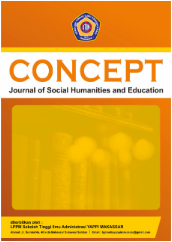Hubungan Antara Gaya Kelekatan dengan Interaksi Parasosial pada Penggemar K-POP
DOI:
https://doi.org/10.55606/concept.v4i1.1821Keywords:
attachment styles, k-pop fans, parasocial interactionAbstract
This study examines the relationship between attachment styles and parasocial interaction among K-pop fans, where fans may develop an emotional bond with their idols despite the lack of real reciprocity. Attachment styles influence the level of attachment, with individuals with an anxious attachment style tending to be more emotionally involved and dependent on their idols, while those with an avoidant attachment style maintain more emotional distance. The role of social media in reinforcing the illusion of closeness is also a key focus of this study. The research aims to identify the relationship between attachment styles and parasocial interaction using a quantitative method with a correlation analysis approach. The findings indicate that fans with an anxious attachment style tend to have a more intense emotional bond, actively participate in fandom activities, and are more prone to anxiety when they lack updates about their idols. In contrast, those with an avoidant attachment style still consume idol-related content but with lower emotional involvement. The theoretical implication of this study supports the theories of attachment styles and parasocial interaction, explaining how emotional relationships form between fans and idols. Practically, this study can be used to develop digital literacy programs for K-pop fans to help them manage parasocial relationships in a healthier way, especially for individuals who are more vulnerable to excessive emotional attachment.
References
Abigail Firsta, S., & Putu, N. (2023). Korelasi gaya kelekatan dan hubungan parasosial pada fans K-Pop di Indonesia (Doctoral dissertation).
Ainsworth, M. (1969). Object relations, dependency, and attachment: A theoretical review of the infant-mother relationship. Child Development, 40(4), 969–1025. https://doi.org/xxxx
Ainsworth, M. D. (1970). Attachment, exploration, and separation: Illustrated by the behavior of one-year-olds in a strange situation. Child Development, 41(1), 49–67. https://doi.org/xxxx
Asees, S., Jaypal, M., Sagar, S., Thomas, S. A., Prasad, S. S., & Varghese, B. A. (2023). A study on romantic attachment style and parasocial relationships. International Journal of Indian Psychology, 11(3). https://doi.org/xxxx
Bartholomew, K. (1994). Models of the self and other: Fundamental dimensions underlying measures of adult attachment. Journal of Personality and Social Psychology, 67(3), 430–445. https://doi.org/xxxx
Bartholomew, K., & Horowitz, L. M. (1991). Attachment styles among young adults: A test of a four-category model. Journal of Personality and Social Psychology, 61(2), 226–244. https://doi.org/xxxx
Bowlby, J. (1958). The nature of the child's tie to his mother. The International Journal of Psychoanalysis, 39, 350–373.
Falencia, A., & G, Frederick. (2023). Pengaruh budaya popular Korea terhadap minat untuk mengunjungi Korea Selatan (Survey terhadap mahasiswa Universitas Sam Ratulangi Manado). Jurnal EMBA, 11(1), 65–76.
Giyani. (2021). Disability self-evaluation for low back pain in COVID-19 pandemic. Indonesian Journal of Physical Medicine and Rehabilitation, 10(2), 99–108.
Hoffner, C. A. (2002). Attachment to media characters. Macmillan Reference.
Horton, D., & Wohl, R. (1956). Mass communication and para-social interaction: Observations on intimacy at a distance. Psychiatry, 19(3), 215–229. https://doi.org/xxxx
Nashwa, O. (2015). Pengaruh attachment styles dan loneliness terhadap interaksi parasosial penggemar Kpop (Bachelor's thesis, UIN Syarif Hidayatullah Jakarta, Fakultas Psikologi).
Valencia, C., & Jetie, K. (2022). Korean Wave; Fenomena budaya pop Korea pada remaja milenial di Indonesia. Jurnal Diversita, 8(2), 205–214.
Xiaowei. (2009). Korean Wave – The popular culture, comes as both cultural and economic imperialism in the East Asia. Asian Social Science, 5(8), 123–131. https://doi.org/xxxx
Downloads
Published
How to Cite
Issue
Section
License
Copyright (c) 2025 Pipit Nopiyanti, Anniez Rachmawati Musslifah, Faqih Purnomosidi

This work is licensed under a Creative Commons Attribution-ShareAlike 4.0 International License.







